Download: How To Make A Compost Step By Step (With Pictures)
Are you looking for an effective and inexpensive way to keep the nutrients in your garden soil intact? Then making compost should be your first choice. Learn how to make compost at home in this step-by-step
guide.
Here is the short answer: to make compost at home, just find a location in your backyard, place your compost bin or pile and fill it with alternate layers of green and brown organic matter.
The alternate layers should be in the following format: greens, browns, greens; green, browns, green. Then, give your compost time to decompose.
Read on for a detailed step-by-step guide to composting for beginners.
What is a Compost?
Compost can be explained as organic matter, which is broken down into simple organic and inorganic materials through the process known as composting.
In other words, it is a process whereby different organic substances such as sawdust, plants, newspaper, and eggshells that were considered
waste products are recycled in order to make a soil conditioner.
Compost has numerous benefits both on agricultural land and the productivity of plants. It helps add nutrients to the soil and also improves soil quality such as wetland construction, erosion control, and landfill cover.
Related: How To Prepare A Garden Plot With Pictures
Types of Compost
There are basically two types of composting, and they include:
- Hot composting
- Cold composting
Hot Compost
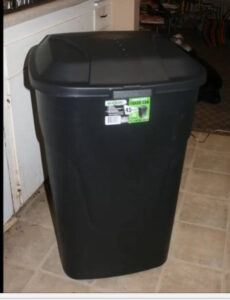
compost bin
This method of composting is called hot because the process of composting can generate internal heat with a temperature of around 160°F. The composting process is fast and can produce efficient garden humus.
The size of the compost bin for hot compost is a 3-foot cube. However, a 4-foot cube is most preferred
Cold Compost
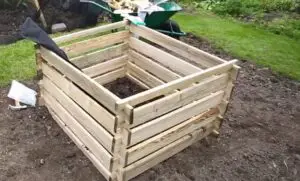
compost pile
Cold compost only requires the Gardner to build a pile of alternate layers of organic materials such as shredded papers, straw, fallen leaves, and grass clippings into a pile to compost.
Because the process is open, this process takes longer to complete. However, the gardener needs not to put more effort to get the process done. Learn on types of composting
Related: How To Grow Plants From Seeds Step By Step
What is Suitable for Composting?
It is important to add good organic materials to your compost, this is because adding irrelevant materials can delay the process of composting and at the same time damage your compost.
Here are the best materials considered suitable for composting:
- Fruits waste
- Grass cuttings
- Eggshells
- Newspapers
- Cardboard
- Fallen leaves
- Vegetable peelings
- Plant prunings
- Scrunched up papers
- Straw
- Sawdust
- Coffee grounds
These types of materials are fast to break down and can provide a large amount of nitrogen and carbon alongside other materials.
What is not Suitable for Composting?
There are also some materials or organic waste that you need to avoid adding to your compost. These materials take forever to compost and can damage your compost.
These materials include:
- Carnivores feces such as cat and dog
- Perennial weeds
- Materials that contain fatty substances, grease, and meat
- Dairy products
- Wood ashes from treated wood
- Sawdust or chips from pressured attested wood
- Diseased plant materials
How to Make the Best Compost at Home
Making compost at home is very easy and you don’t need to break your bank in buying compost starters and other expensive things before getting the compost done.
Here is an easy way to compost at home:
- Pick a good Compost bin
- Locate a spot with good sunlight
- Add green and Brown organic matters
- Alternate between layers
- Wet the compost timely
- Turn the compost timely
Related: How To Select Good Seeds For Planting In 2020
1. Pick a good Compost Bin
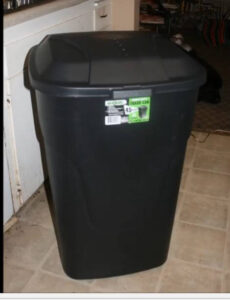
The first step to making compost is to choose where you will make the compost. You can make the compost in a pile. However, this process takes time.
The next option, which is effective and fast is to compost in a bin. The process of composting in the bin is very fast because heat is conserved, which speeds up the composting process.
The size of the compost bin solely depends on the amount of compost you want. If you want more compost to feed your garden plants, then you need to choose a big compost bin. And if you want small compost, then you need to pick a small compost bin.
Tip: if you want to get the work done and want to produce compost fast, I recommend you buy a compost grinder. You can get an outdoor composter at a cheap price on Amazon. Click here for pricing on Amazon.
2. Locate a Spot with good Sunlight
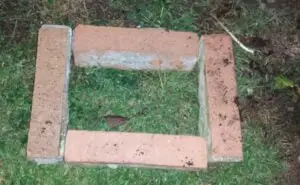
Find a place around your backyard that receives a sufficient amount of sunlight. This helps provide your compost with heat that can spread up the composting process.
3. Keep the Compost Bin in a Good Place
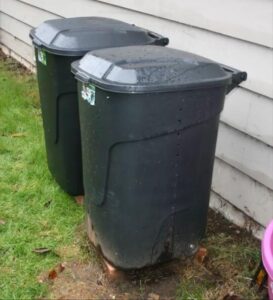
The surface where you will keep the compost bin needs to be flat and free from any kind of natural disaster. The surface of the place also needs to be well-drained without complete.
Related: What Are The Best Garden Seeds To Buy? The Ultimate Garden Seeds Buying Guide
4. Add Green and Brown Organic Materials
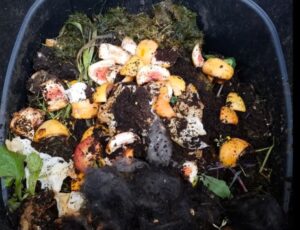
You need a mixture of organic and inorganic materials so that the compost will contain all the necessary nutrients that are required by plants.
The compost needs to contain the correct proportion of nitrogen, carbon, oxygen, and water. In order to make your compost contains both nitrogen and carbon, you need to add Brown and Green organic matters.
The brown materials help absorb excess water and prevent the compost from releasing out the unpleasant odors. On the other hand, green materials add nitrogen, moisture, and also help conserve heat.
Examples of Brown organic materials are the bark of trees, dried leaves, paper eggs, cartons, evergreen needles, dead house plants, cardboard, straw, dried grass clippings, and shredded newsprint.
And the examples of green materials include green leaves, garden waste, fruit peels (but avoid citrus peels), coffee grounds, eggshells, vegetables, and flowers.
5. Alternate Between Layers
You need to alternate between layers of Brown and green materials. Start filling the compost bin with garden soil that is well aerated and has decomposers such as earthworms.
Then, add green leaves and other green materials. Then, follow the green layer with a second layer of brown materials. Continue alternating between green and brown matters in the following format: green, brown, green, brown; brown, green, brown, green.
6. Wet the Compost Timely
When the compost looks too dry, that is an indication that the brown matters overweight the green matters. In this case, you need to gently moisten the compost with water. Please, avoid dumping up as this can damage your compost.
Related: How To Choose A Garden Spot (Step By Step Guide)
You can also add more fresh green materials. This also helps keep the compost moisture intact.
7. Turn the Compost Timely
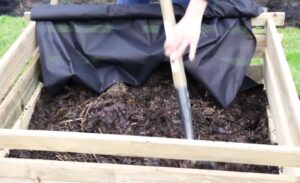
While adding and alternating between composting materials, make sure you are turning the compost at least once a week. This can help maintain moisture and conserve heat. It also helps combine the composting mixture evenly. As you add the composting materials, you turn until the compost bin is filled up.
How long does it take to make Compost?
The time your compost can take depends on so many things:
To make sure all added composting materials are properly broken down to the point where you can’t distinguish the added composting materials depends on how much heat and moisture the compost is receiving and conserving internally.
It also depends on how the compostables are layered. The size of the compost also affects how long compost can take to be decomposed.
Small size compost usually takes a long time before the composting process to be completed. On the other hand, large or big size compost usually takes a shorter time to be decomposed.
Related: How To Start A Garden From Scratch In 2020 (Step By Step Guide)
In general, compost that is made in a compost bin usually takes 3 months to 1 year if the layers of suitable organic materials are properly arranged.
How do you know when Compost is Ready?
A properly finished and completed compost will look dark and crumbly that release a please odor like that of earth.
The compost that is properly decomposed bin or pile. Take out all the compost that fully decomposed from the compost bin while those organic materials that are yet to be decomposed should be allowed to finish decomposing.
What will happen if you left the Compost too Long?
If the compost is left in the Ben or pile for too long, the compost can still be useful for years as long as both moisture and heat are conserved.
However, the compost will eventually get contaminated and nutrients will leach. Additionally, other microorganisms such as fungi can start to feed on the compost and contaminate it completely.
Read also: Can You Compost Bread: The Ultimate Bread Composting Guide
What is Bad about Composting?
There are many health and safety concerns about compost if everything is not done correctly. You need to follow the basic process of composting. Failure to follow these rules can result in much environmental contamination.
For instance, compost should not contain fats, meat, bone scraps, human feces, cat and dog feces, and whole eggs. And when you add these substances to the compost, they can make the compost smell bad, which will attract pests.
Additionally, another bad thing about compost is that the finished compost may contain bacteria, which can cause foodborne diseases.
Compost can also cause nutrition imbalance in the soil when the carbon compound is not in proportion with that of the nitrogen compound. A compost is required to contain carbon and nitrogen in a ratio of 30:1.
Wrapping Up
Compost can help the soil retain moisture and also encourage the growth of useful soil organisms such as earthworms while reducing disease susceptibility in the garden.
It also helps lower the need for chemical fertilizers and is useful for lowering carbon footprint.
As it was reported by the Environmental Protection Agency (APE), waste organic materials make up more than 28% of what is thrown away from our homes and agricultural settings.
Thus, it will be wise to think of how to recycle these nutrient-rich materials into something that will benefit our beloved plants.
In this guide, I looked at how to make a compost step by step at home from simple waste that we can get from kitchens and gardens.
I hope this article was of excellent to you in understanding how to make the best compost at home. Let us hear your questions in the comments section below.
